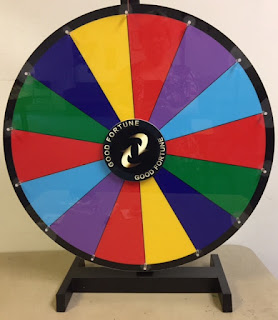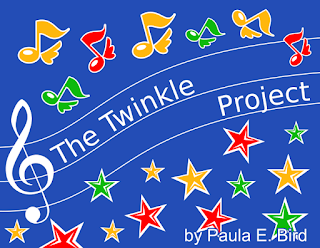 |
| The Wheel of Music |
"What's that?"
"What is it for?"
"How do you use it?"
The wheel generated a lot of buzz among the students, and not just the youngest students. Parents and siblings showed interest in it as well. During this preparatory time leading up to the wheel's initial use in class, I thought of ways to use it. Here are a few activity ideas and my discoveries of what the various colors on the wheel could represent:
- Students could touch the tip of the bow to something in the studio that has the same color as the color that the wheel spin lands on. This was another bow game activity that was very popular with the younger students, although there were some laugh-out-loud moments with the older students as well when I turned around and found two older students locked in a tableau of pointing their bows at something on each other's shirts. One boy stood there as if he were about to commit harikari.
- The students helped me decide what activity to put on the wheel. Occasionally I would alter a suggested activity to add something new and pique their curiosity ("What are we going to do with the 'toy bears'?" In this way I learned quickly which were their favorite activities and games, because they were eager to shout them out to me to put on the wheel. They included things like: water cups, hide the rosin, and even the Twinkle Variations.
- My students came up with nicknames of their own for the Twinkle Variations: "eat boogers" (Variation C), "Pika-ch-u" (Variation B). [What can I say? The studio enjoys the energy of a few younger boys.] I was surprised how much fun the students had with the simple activity of writing things on the wheel before class officially began.
- The colors could represent a kind of activity, and there could be lists of things on a color chart or paper:
- Bow games: Up Like a Rocket, Pass the Cup, Through the Loop
- Concentration and focus activities: water cups, zombie walk, toy bear sticks
- Rhythm activities: awesome rhythm sticks, I Know a Fox With Dirty Socks (affiliate links)
- Twinkle Variations: Twinkle reviews and new challenges (G Major Twinkle, different keys, higher positions, backwards bows, upside down bows)
- Singing activities
- Spinner's choice: I asked students to consider in advance what activity they might choose if the wheel landed on this space, so that the student would be ready to go with a choice of activity
- Special "challenges":
- Stick out your tongue
- Stand on one foot
- Play with eyes closed
- Stand back to back with another student for posture
- Stand with the back of the upper bow arms touching each other for posture
- Play song sections out of order (Scramble Game)
As the students finished each activity on the spinning wheel, we erased the dry erase mark from the wheel. At this point, we had additional options to consider:
- The students could add a new activity to replace the activity they had just completed
- Students could leave the space blank and continue spinning until all activities were finished
- There could be a combination of things added to the wheel, such as student's choice, teacher's choice, and parent's choice
There may be other options to include:
- Students could also play for the other students in order to "earn" the chance to spin the wheel.
- The wheel colors could represent a pick from different prize boxes. The prize boxes could include very simple items, such as craft beads of matching colors.
My favorite idea, which was borne out of a conversation with a young student who made the mistake of saying they sometimes got "bored" at home, was to make a "Boring Chores" wheel at home. The parents and students could list various "boring" chores on the wheel, such as "take out the trash," "dust your room," or "clean a toilet." Then if someone were to say they were "bored," they would have to spin the wheel and do the chore listed on the wheel. This idea led some of my students and parents to come up with all sorts of variations, from performing regular chores to earning special treats.
My students had a great deal of fun with the color spinning wheel in group class. Even my shyest students really got involved in the spinning activities. There was so much excitement and fun, and I noticed that even my most fearful students lost themselves in all the fun.
We use the larger version of the wheel in the studio, but there are smaller versions available as well. If you try this idea, be sure to comment below or email me and tell me your favorite ways to use the wheel. I highly recommend this fun activity and teaching tool!
For more information about the spinning color wheel, click here (affiliate link). The wheel also comes in other sizes. We use the wheel that is linked here.
Many of the activities listed above can be found in my new resource book, The Twinkle Project. I wrote this book as a collection of resources and teaching steps from the beginning stages of learning the violin up to and including the Twinkle Variations. I include many activities to build concentration and focus and explain in depth the many possible ways to learn and later combine the parts of the Twinkle Variations to get the most optimum concentration and focus benefit. For more information about the book, click here. Here are links to the two videos about the book: (Why Did I Write This Book? and What's the Book About?).
 |
| The Twinkle Project |
I am eager to hear of your teaching ideas with the spinning wheel!
Happy Practicing!
----- Paula -----
© 2017 by Paula E. Bird
If you found this episode (or any episode) of the podcast helpful, and you would like to make a donation to support the Teach Suzuki Podcast and the blog, click here. My efforts to write and produce the Teach Suzuki blog and podcast do not generate income except through the generosity of those readers and listeners. I really appreciate your support. Just click here for a direct link to PayPal to support the blog and podcast.
No comments:
Post a Comment